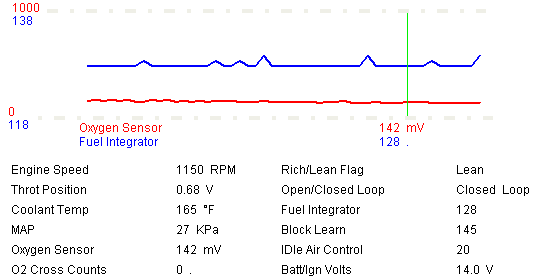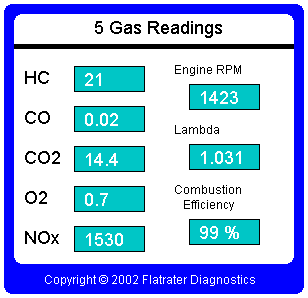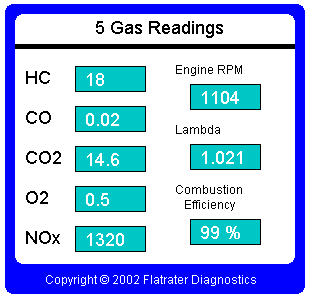Why is our idle speed so high?
From part one:
The throttle body minimum air rate cap is still
in place and the TPS in not adjustable

I would say the ECM knows that the throttle is closed.
Wouldn't we expect it to try to bring the engine speed down by
commanding the IAC valve to close off the air passage (lower iac counts)?
165° F is not cold enough for a commanded rpm of 1150... You would think
the IAC counts would be 0.
I'd be lying if I told you I carefully examined the scan
data for anomalies etc at this point. I did what most of you would have
done. I grabbed a can of brake clean and shot a stream at the throttle
body base. Yep! Its leaking vacuum... Replacing the gasket took care of
the high idle, the functional failure, and brought lambda very close to
perfect.
The truck will now pass the smog inspection with flying
colors. But do we just ignore the scan data? What's going on with the high
idle speed and the lack of ECM attempt to lower it?
I think the answer lies in an obscure TSB and system
strategy.
ESI Document ID # 226356
REVISED TECH 1 MASS STORAGE CARTRIDGE (MSC) OXYGEN SENSOR #51-65-47
REVISION: 01/18/96
SUBJECT: REVISED TECH 1 MASS STORAGE CARTRIDGE (MSC) OXYGEN SENSOR TEST
A snippet....
THERE ARE SOME APPLICATIONS (FOR EXAMPLE THE
'88/'89 5.0/5.7L TBI TRUCK) THAT COMMAND O2S VOLTAGE UNDER 150 MV DURING
HIGH RPM AND LOW LOAD CONDITIONS LIKE THOSE EXISTING DURING THE O2S TEST
TO DETERMINE IF YOUR VEHICLE HAS THIS FUEL
CONTROL CALIBRATION, HOLD ENGINE SPEED AT 2000 RPM WHILE MONITORING O2
VOLTAGE AND SHORT TERM FUEL TRIM. IF THE VEHICLE HAS THIS CALIBRATION, THE
SHORT TERM FUEL TRIM WILL BE FIXED AT 128 WHILE THE O2S VOLTAGE REMAINS
LOW((150 MV).
Under
the above conditions the ECM will go into decel enleanment mode. The blown
TBI gasket somewhat simulates a cracked throttle and so (with the extra
fuel now added) we have a very low load (engine vacuum around
21").

I think this fits.... with the oxygen sensor voltage fixed
below 450mv and the integrator pretty much stuck at 128, I believe we can
say fuel trim learn has been disabled.
The block learn of 145 I believe is due to the blown
throttle body gasket. The gasket is torn on only one side of the throttle
body and so will be affecting one plane of the manifold more than the
other.
The big question of why the ECM is reacting this way
knowing full well the throttle is closed is not something I can answer
except to say.... Its just one of those things.... (g)
If we had monitored the oxygen sensor signal while the
truck was on the dyno we would have seen it switching normally.
In closing let me mention a scan tool anomaly. The Tech 1
displayed the Air Control Solenoid command PID. The truck is not equipped
with air injection. That's just another one of those things.... (g)
I wish I could go back 15 years with the knowledge and
tools I have now. There were so many odd and interesting things I just
blasted through. So many lost opportunities... (g)

|




